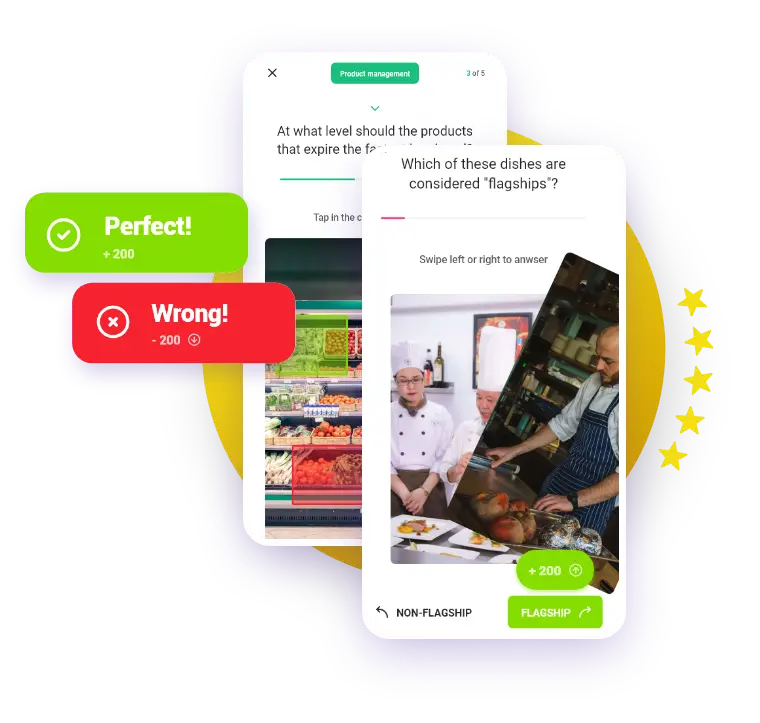Table of contents
ToggleThe modern workforce is changing. becoming increasingly diverse, automated, digital and global. These changes, and the speed at which they occur, are forcing companies to devise new rules for how they should manage talent retention.
In recent times, employees have gained an increased influence in the work environment, leading them to new expectations about their workplaces. Today, workers can easily change jobs, seeking new challenges that sometimes go beyond the need for a particular salary. In fact, according to Forbes, millions of employees across multiple sectors around the world have taken part in a mass exodus from their workplaces over the past 2 years.
That’s why, today more than ever, companies must seek new models if they wish to continue attracting talent during all stages of employment. This means that employers need not only to earn candidates’ interest at the early stages of hiring and onboarding, but also gain their commitment and loyalty throughout and, crucially, never take them for granted. The loss of talent has an economic cost, but, more importantly, a ‘contagious’ effect, and can spread quickly, like a virus.
What is staff retention and what does it entail?
Talent retention, at its simplest, refers to a set of strategies and practices designed to keep the most valuable employees within an organization over the long term. This means not only keeping them satisfied in their current roles, but also offering them further opportunities for professional growth and personal development that incentivize them to stay with the company. In order to achieve this, it’s essential to cultivate an environment where they can grow, prosper and contribute to the ongoing development of the company.
Why is employee retention so important? The benefits for companies
Employee retention is fundamental for the stability and growth of a company, as it allows valuable knowledge and experience to be kept within the organization (thereby avoiding the much feared talent drain). Thus, companies that manage to secure a high level of talent retention can enjoy a series of benefits:
- Greater productivity: Employees with more experience and better knowledge of the company’s product or service are generally more efficient and productive.
- A better work environment: A stable team helps to foster a more positive and collaborative work environment.
- Cost reduction: High personnel turnover typically leads to higher recruitment and training costs. We’ll talk about this in more detail later.
- Heightened innovation: Loyal and engaged employees are more likely to contribute new ideas and solutions.
- Improved brand image: A company that retains its employees is viewed as a good place to work, which makes it easier for it to attract talent.
Myths about employee retention
There are several persistent myths concerning which factors lead to successful (or unsuccessful) employee retention levels, and these are important to analyze if you wish to follow a successful retention strategy. Some of these myths include:
- Money is everything: While compensation is an important factor, it is not the only one that motivates employees. Professional development, recognition for achievements, and work flexibility are also key.
- Young employees are more likely to leave: Employee turnover affects all ages. It’s important to create an attractive work environment for all employees.
- Talent retention is an expensive process: It doesn’t have to be. There are many low-cost strategies that can be highly effective in keeping your staff motivated.
How do you know if an employee is about to leave the company?
Being able to identify the signs that an employee might be considering leaving a company is essential, especially if you want to take preventative measures. What are the most common signs? Take note:
- Decreased performance: Low productivity, a lack of initiative and frequent errors.
- Demotivation: A Lack of enthusiasm for work and disinterest in new ideas.
- Dissatisfaction: Constant complaints and criticisms of the company, the team and other colleagues.
- A search for new opportunities: This can be detected by observing increased activity on professional social networks, such as LinkedIn.
What is the true cost of high staff turnover?
Staff turnover can be costly for businesses, both financially and in terms of its impact on team productivity and morale. These costs fall into two distinct categories:
1. Direct costs
Examples of direct costs include expenses for recruiting, selecting and training new employees – for example, publishing a job ad through an external platform, or the cost of the selection process if the service is outsourced.
2. Indirect costs
Indirect costs typically manifest themselves in decreased productivity and loss of customers due to lack of continuity in employee service. Because of this, it’s vital to properly calculate the time it takes for a new employee to reach their maximum performance.
According to Gallup, taking into account both direct and indirect factors, the cost of replacing an employee can range from 0.5 to 2 times the employee’s annual salary.
New talent attraction and retention models: 6 key strategies
A few years ago, attracting talent depended solely on the image or public perception of a company, and its value proposition. However, in the new era of increasingly critical and selective talent, companies are beginning to understand that attracting talent also depends on several external elements. These can include feedback on the hiring experience, or even the opinions of colleagues.
Such external elements have changed the rules of the game when it comes to devising talent acquisition and retention strategies, and call for new actions to be taken on the part of companies. Below, we share some fundamental strategies to help with the process.
1. Create an EVP that is truly attractive
The employee value proposition is the set of privileges, rewards or benefits that a company promises to provide to its employees in connection to their way of working and environment. These are given in exchange for their capabilities, experiences and skills. EVP includes everything from the design of the workplace, to the development programs available to employees, and even to its corporate culture. This latter element extends to cover broader aspects such as inclusion and sustainability.
Employees will consider an EVP very carefully, so in addition to the traditional value proposition that simply includes privileges, benefits and salary, a company must also seek to make their workforce feel that they can identify with it. When you create and share your EVP, keep in mind that potential employees need to see themselves reflected in it. This means you need to create an impact in the minds of your candidates, and that it should continue having an effect even after the hiring process. Ensure that you remain open to suggestions and feedback from employees.
2. Review and renew your talent acquisition strategies
The battle for talent has always been ongoing, but today it is more intense than ever. The new rules mentioned above have forced companies to review and adjust their approach to attracting talent, and below are just a few of the changes they can make in order to strengthen their strategies:
- Forge a connection between candidates and existing employees
What could be more direct than an employee’s testimonial about their onboarding and overall experience at the company? Using testimonials, especially from more recent employees, gives companies a good opportunity to impress new candidates.
Another recruitment strategy you might wish to implement is searching for candidates through a referral program. Both of the processes we outline here can enhance both the quality and quantity of hires, as well as improve retention rates.
- Get noticed as a company
Companies must always be aware of the expectations of new workers, and adapt what they offer to be more attractive. Propositions that will make your company stand out include: flexibility; development opportunities; transparency on the company’s values and mission; an inclusive culture; and the use of innovative technology.
- Take advantage of virtual experiences
Many companies carry out their selection processes virtually. Although for some this method may have certain limitations when compared to traditional processes, it’s important to highlight that they also offer advantages – both in terms of accelerating the whole process and saving resources.
Companies can also offer their candidates an online experience that effectively conveys the organization’s values. This requires a combination of good technology, clear communication and personalization (for individual candidates). It can be achieved with the aid of tools such as video conferencing platforms, and by providing candidates with clear information, timelines, requirements and expectations. However, take care to treat each candidate as an individual, and offer personalized feedback after each stage of the process.
3. Attracting talent doesn’t end with hiring
It’s important for companies to keep in mind that, when it comes to attracting and retaining talent, the strategy does not simply end once a candidate has signed the contract and become part of the staff, but in fact continues. This is why it’s so important to offer a good onboarding experience which, according to Glassdoor, can improve the loyalty of new employees by up to 82%, and their productivity by up to 70%.
Clearly communicating to new employees their responsibilities, their role within the company, and the first actions they need to take are great differentiators of a good onboarding process. Companies that get it right at this stage are able to improve the commitment and motivation of their employees from day one.
4. Hold more two-way conversations
You should aim to maintain constant communication with employees, not only to remind them why they were attracted to the company in the first place, but also to illustrate that their growth and development remains a priority.
For any professional, feedback on their performance is essential to help them improve their performance and stay engaged with the organization. However, it isn’t enough just to have a conversation about this – it’s crucial to actually improve the quality.
To this end, employers must help professionals to identify their objectives, so that they can offer them growth and development opportunities that also suit the needs of the organization. Be sure to provide constructive criticism, as well as reward achievements. Additionally, assign tasks and projects that give employees autonomy, and take their suggestions, opinions, and ideas into account for future endeavors.
5. Forge a link between wellbeing and performance
Wellbeing has risen dramatically on the list of priorities when it comes to choosing a job, particularly after the pandemic. Levels of stress and anxiety in the workplace are especially high amongst millennials and Generation Z, of whom 4 in 10 have felt overwhelmed due to the nature of their environment and the demands of their jobs, according to a survey by Deloitte.
Offering resources that improve employee wellbeing is crucial to ensuring that they feel comfortable within the organization, and therefore ensuring their retention. You can achieve this through training in skills such as empathy, leadership and communication.
6. Accommodate employee development and growth
Employee expectations have increased in relation to their professional development, and this fact, coupled with constant change in the demand for skills, emphasizes the need for companies to provide continuous learning and development opportunities.
On this point, companies must take two important factors into account. First, employees expect companies to help them develop their professional careers, regardless of how long they decide to stay with the company. Second, traditional learning methods are quickly changing, and face being replaced by methodologies that use technology as the prime means of content creation and distribution.
Training through practical methodologies that suit the new digital reality is a valuable means of improving the employee learning experience. Some of the most prominent of these methodologies include microlearning, gamified learning and social learning.
Key metrics to evaluate success: analyze the performance of retention and recruitment
To measure the success of talent retention strategies, it’s important to use specific metrics that allow you to evaluate retention and acquisition outcomes. Here are some key metrics to keep in mind:
- Retention rate: The percentage of employees who remain with the company for a given period of time.
- Length of stay: The average length of time that employees remain in the company.
- Turnover cost: The total cost of staff turnover.
- Employee satisfaction: How satisfied are employees with their jobs and the company?
In short, talent attraction and retention must continue to take place at each and every stage of employment. From recruitment, to hiring and the onboarding process, and on into their development within the company, employees should be evaluated and provided with the tools they need for professional growth.
Human resources managers must strive to understand that the new era of work requires significant changes in talent acquisition and retention strategies. These twin strategies go hand-in-hand, and should ideally continue long after the candidate first becomes an employee.
At isEazy, we have the ideal solution, helping you combine the best strategies to enhance talent retention in your company. Discover isEazy Engage, the onboarding and training app for your professionals, that unites a host of powerful features to train and engage your team. Take advantage of microlearning, communication, gamification and task management, and all from the palm of your hand. Request a demo today!















